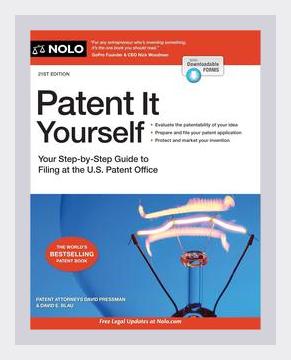Business Law and EthicsIntellectual Property
“Patent It Yourself: Your Step-by-Step Guide to Filing at the U.S. Patent Office” by David Pressman and David E. Blau serves as a comprehensive manual for inventors looking to navigate the complex process of obtaining a patent without hiring an attorney. Below is a structured summary highlighting the key points and actions from this 2018 edition:
Introduction to Patents and Preparation
- Understanding Patents: The book begins by explaining what patents are, why they are important, and the different types of patents (Utility, Design, and Plant). Patents grant inventors exclusive rights to their inventions, preventing others from making, using, or selling the invention without permission.
Action: Identify what type of patent (Utility, Design, or Plant) is suitable for your invention based on its nature and scope.
Determining Patentability
- Novelty and Non-Obviousness: Pressman and Blau emphasize the importance of ensuring that the invention is novel (new) and non-obvious (not easily deductible by someone with ordinary skills in the field). They recommend conducting a thorough search to determine if the invention meets these criteria.
Example: Performing a patent search using the USPTO’s online database to check for similar inventions.
Action: Conduct a comprehensive search using Google Patents, USPTO database, and other patent databases to confirm the novelty of your invention.
Drafting the Application
- Parts of a Patent Application: The book meticulously details the parts of a patent application, including the Abstract, Specification, Claims, Drawings, and Oath/Declaration. Each section must be carefully crafted to meet the USPTO requirements.
Example: The Specification should include a detailed description of the invention, its advantages, and its best way to make and use it.
Action: Draft a detailed specification for your invention, ensuring to include every possible embodiment and variant you can think of.
Claims: The Heart of the Patent
- Crafting Claims: The authors highlight that claims define the legal scope of the patent protection. Properly drafted claims are crucial to the enforceability of a patent.
Example: Writing both broad and narrow claims to ensure that the invention is well-protected against competitors.
Action: Write a set of claims, starting with broad claims that encompass the general inventive concept and more specific claims that cover particular embodiments of the invention.
Drawings and Figures
- Creating Effective Drawings: High-quality drawings or figures are essential for clarity and are required for nearly all patent applications. They must adhere to specific guidelines set by the USPTO.
Example: Using multiple views (e.g., top, side, perspective) to fully showcase the invention.
Action: Create detailed, labeled drawings of your invention using drawing software or by hiring a professional draftsperson to ensure compliance with USPTO standards.
Filing the Application
- Submission Process: Pressman and Blau explain the step-by-step process of submitting the patent application to the USPTO, including electronic filing options which speed up the process.
Example: Using the Electronic Filing System (EFS-Web) provided by the USPTO for submission.
Action: Prepare and submit your application using the USPTO’s EFS-Web system, ensuring all required documents and fees are included.
Responding to Office Actions
- Handling Examiner’s Reports: After filing, an examiner reviews the application and usually issues an office action that requires a response. The authors guide how to argue rejections effectively and amend claims if necessary.
Example: Receiving a rejection based on prior art and drafting a response that highlights differences between your invention and the cited prior art.
Action: Carefully review the examiner’s office action, draft a well-reasoned response, and make necessary amendments to the claims or specification.
Provisional Applications
- Advantages of Provisional Patents: The book covers provisional patent applications, which allow inventors to secure an early filing date while giving them a year to file a non-provisional application.
Example: Filing a provisional patent to test the market or seek investors while securing a priority date.
Action: File a provisional patent application with a full description of your invention to secure a filing date, giving you a year to decide if you want to pursue a non-provisional patent.
International Patents
- Protecting Inventions Globally: The authors discuss the Patent Cooperation Treaty (PCT) process for seeking patent protection in multiple countries.
Example: Filing an international application through the PCT to cover Europe, Asia, and other continents.
Action: File a PCT application within one year of your U.S. filing date to seek international patent protection.
Maintaining and Enforcing Patents
-
Maintaining Patent Rights: Regular maintenance fees must be paid to keep patents in force. The book details the timeline and process for these payments.
Example: Paying maintenance fees at 3.5, 7.5, and 11.5 years after issuance.
Action: Set reminders for the maintenance fee deadlines to ensure your patent remains active. -
Enforcing Patent Rights: Pressman and Blau explain the steps to enforce patent rights if infringement occurs, including negotiation, licensing, and litigation.
Example: Sending a cease-and-desist letter to an infringer to seek resolution without court involvement.
Action: Consult a patent attorney if you encounter infringement and develop a strategy for enforcing your patent rights.
Conclusion and Final Tips
- DIY Patent Filing: The authors reaffirm that while filing a patent application on your own is challenging, it is possible with diligence and attention to detail.
Example: Many successful inventors have navigated the process themselves by following structured guidance like the one provided in the book.
Action: Use the book as a continual reference throughout the patent process, ensuring you follow all outlined steps diligently.
Appendix and Resources
- Additional Tools: The book includes forms, checklists, and resources that are valuable during the application process.
Action: Utilize provided checklists to verify that your patent application is complete and meets all USPTO requirements.
This comprehensive guide by Pressman and Blau not only demystifies the patent process but also empowers inventors with the knowledge and tools necessary to protect their intellectual property independently.
